Modeling and Experimental Analysis on the Temperature Response of AlN-Film Based SAWRs
Abstract
:1. Introduction
2. Modeling
2.1. Modification of the Equivalent Circuit of IDT
2.2. Parallel Parasitic Parameters Introduced from the Conducting Lines
2.3. Modified Equivalent Circuit of AlN/Si SAWR
2.4. Temperature Response of Electrical Performance Based on the Modified Equivalent Circuit Model
2.5. Temperature Response of Center Frequency
3. Experimental Section
4. Results and Discussion
5. Conclusions
Acknowledgments
Author Contributions
Conflicts of Interest
Abbreviations
| SAWR | Surface acoustic wave resonator |
| TCF | Temperature coefficient factor |
| IDT | Inter-digital transducer |
| FWHM | Full width at half maximum |
Appendix A
| Parameters | Value/Unit | Parameters | Value/Unit |
|---|---|---|---|
| c11,AlN | 408.03/GPa | c44,SiC | 137/GPa |
| c12,AlN | 100.18/GPa | c66,SiC | 153/GPa |
| c13,AlN | 83.40/GPa | 3216/kg·m−3 | |
| c33,AlN | 384.30/GPa | 9.7 | |
| c44,AlN | 100.08/GPa | ts,Si | 400/μm |
| c66,AlN | 153.93/GPa | tp,AlN-Si | 3/μm |
| 3260/kg·m−3 | ts,SiC | 400/μm | |
| 9 | tp,AlN-SiC | 3/μm | |
| c11,Si | 165.63/GPa | tm | 100/nm |
| c12,Si | 63.87/GPa | N | 50 |
| c44,Si | 79.55/GPa | λ | 12/μm |
| 2329/kg·m−3 | a | 3/μm | |
| c11,Mo | 440.77/GPa | w | 840/μm |
| c12,Mo | 172.43/GPa | NR | 600 |
| c44,Mo | 121.65/GPa | lc1 | 600/μm |
| 10,200/kg·m−3 | lc2 | 5000/μm | |
| 11.7 | wc | 200/μm | |
| c11,SiC | 493/GPa | lt | 7.5/μm |
| c12,SiC | 187/GPa | wcr | 480/μm |
| c13,SiC | 91/GPa | wi | 40/μm |
| c33,SiC | 553/GPa | K2 | 0.2% |
| Parameters | Value/Unit | Parameters | Value/Unit |
|---|---|---|---|
| ref. [32] | ref. [34] | ||
| ref. [32] | ref. [35] | ||
| ref. [32] | ref. [35] | ||
| ref. [28] | ref. [35] | ||
| ref. [28] | ref. [35] | ||
| ref. [28] | c111,AlN | −3072.30/GPa | |
| ref. [29] | c112,AlN | −514.07/GPa | |
| ref. [29] | c113,AlN | −75.06/GPa | |
| ref. [29] | c123,AlN | −155.12/GPa | |
| −37/ppmK−1 | c133,AlN | −614.88/GPa | |
| −65/ppmK−1 | c344,AlN | −576.45/GPa | |
| −50/ppmK−1 | c144,AlN | −150.12/GPa | |
| −50/ppmK−1 | c155,AlN | −100.08/GPa | |
| −1.8/ppmK−1 | c222,AlN | −2413.0/GPa | |
| ref. [34] | c333,AlN | −2213.6/GPa | |
| ref. [34] |
References
- Thiele, J.A.; da Cunha, M.P. High temperature LGS SAW gas sensor. Sens. Actuator B 2006, 113, 816–822. [Google Scholar] [CrossRef]
- Benetti, M.; Cannata, D.; di Pietrantonio, F.; Marchiori, C.; Persichetti, P.; Verona, E. Pressure sensor based on surface acoustic wave resonators. In Proceedings of the 2008 IEEE on Sensors, Lecce, Italy, 26–29 October 2008; pp. 1024–1027.
- García-Gancedo, L.; Milne, W.I.; Luo, J.K.; Flewitt, A.J. Sensors based on SAW and FBAR technologies. In Proceedings of the 4th International Conference on Smart Materials and Nanotechnology in Engineering, International Society for Optics and Photonics, Gold Coast, Australia, 10 July 2013; pp. 879308–879308-7.
- Pohl, A. A review of wireless SAW sensors. IEEE Trans. Ultrason. Ferroelectr. Freq. Control 2000, 47, 317–332. [Google Scholar] [CrossRef] [PubMed]
- Zhang, S.; Yu, F. Piezoelectric materials for high temperature sensor. J. Am. Ceram. Soc. 2011, 10, 3153–3170. [Google Scholar] [CrossRef]
- Hornsteiner, J.; Born, E.; Fischerauer, G.; Riha, E. Surface acoustic wave sensors for high-temperature applications. In Proceedings of the 1998 IEEE International Frequency Control Symposium, Pasadena, CA, USA, 27–29 May 1998; pp. 615–620.
- Farrell, R.; Pagán, V.R.; Kabulski, A.; Kuchibhatla, S.; Harman, J.; Kasarla, K.R. High temperature annealing studies on the piezoelectric properties of thin aluminum nitride films. In MRS Online Proceeding Library; Cambridge University Press: Cambridge, UK, 2008. [Google Scholar]
- Lai, Y.J.; Li, W.C.; Lin, C.M.; Felmetsger, V.V.; Pisano, A.P. High-temperature stable piezoelectric aluminum nitride energy harvesters utilizing elastically supported diaphragms. In Proceedings of the IEEE Transducers & Eurosensors, Barcelona, Spain, 16–20 June 2013; pp. 2268–2271.
- Piazza, G.; Felmetsger, V.; Muralt, P.; Olsson III, R.H.; Ruby, R. Piezoelectric aluminum nitride thin films for microelectromechanical systems. MRS Bull. 2012, 37, 1051–1061. [Google Scholar] [CrossRef]
- Lin, C.M.; Yantchev, V.; Zou, J.; Chen, Y.Y.; Pisano, A.P. Micromachined one-port aluminum nitride lamb wave resonators utilizing the lowest-order symmetric mode. J. Microelectromech. Syst. 2014, 23, 78–91. [Google Scholar] [CrossRef]
- Lin, C.M.; Chen, Y.Y.; Felmetsger, V.V.; Senesky, D.G.; Pisano, A.P. AlN/3C-SiC composite plate enabling high-frequency and high-Q micromechanical resonators. Adv. Mater. 2012, 24, 2722–2727. [Google Scholar] [CrossRef] [PubMed]
- Benetti, M.; Cannata, D.; di Pictrantonio, F.; Verona, E. Growth of AlN piezoelectric film on diamond for high-frequency surface acoustic wave devices. IEEE Trans. Ultrason. Ferroelectr. Freq. Control 2005, 52, 1806–1811. [Google Scholar] [CrossRef] [PubMed]
- Lin, C.M.; Lien, W.C.; Felmetsger, V.V.; Hopcroft, M.A.; Senesky, D.G.; Pisano, A.P. AlN thin films grown on epitaxial 3C-SiC (100) for piezoelectric resonant devices. Appl. Phys. Lett. 2010, 97, 141907. [Google Scholar] [CrossRef]
- Blampain, E.; Elmazria, O.; Aubert, T.; Assouar, B.; Legrani, O. Surface acoustic wave sensor based on AlN/Sapphire structure for high temperature and high frequency applications. In Proceedings of the 2011 IEEE on Sensors, Limerick, Ireland, 28–31 October 2011; pp. 610–613.
- Liaw, H.M.; Cronin, W.; Hickernell, F.S. The SAW characteristics of sputtered aluminum nitride on silicon. In Proceedings of the IEEE Ultrasonics Symposium, Cannes, France, 31 October–3 November 1994; pp. 267–271.
- Lin, C.M.; Chen, Y.Y.; Felmetsger, V.V.; Yen, T.T.; Lien, W.C.; Senesky, D.G.; Pisano, A.P. Surface acoustic wave propagation properties in AlN/3C-SiC/Si composite structure. In Proceedings of the IEEE Ultrasonics Symposium, San Diego, CA, USA, 11–14 October 2010; pp. 1696–1699.
- Zhu, L.; Li, Q.; Liu, K. Modeling of one-port SAW resonator based on ADS. Piezoelectr. Acoustoopt. 2012, 34, 17–23. [Google Scholar]
- Hashimoto, K.Y. Surface Acoustic Wave Devices in Telecommunications; Springer: Berlin, Germany, 2000. [Google Scholar]
- Kojima, T.; Shibayama, K. An analysis of reflection characteristics of the surface-acoustic-wave reflector by an equivalent circuit model. Jpn. J. Appl. Phys. 1987, 26, 117–119. [Google Scholar] [CrossRef]
- Smith, W.R.; Gerard, H.M.; Collins, J.H.; Reeder, H.M.; Shaw, H.J. Analysis of interdigital surface wave transducers by use of an equivalent circuit model. IEEE Trans. Microw. Theory Tech. 1969, 17, 856–864. [Google Scholar] [CrossRef]
- Tang, G.; Han, T.; Teshigahara, A.; Iwaki, T. Enhancement of effective electromechanical coupling factor by mass loading in layered SAW device structures. In Proceedings of the 2015 Joint Conference of the IEEE International Frequency Control Symposium & the European Frequency and Time Forum, Denver, CO, USA, 12–16 April 2015; pp. 416–419.
- Blampain, E.; Elmazria, O.; Legrani, O.; McMurtry, S.; Montaigne, F.; Fu, C.; Yang, S.S. Platinum/AlN/Sapphire SAW resonator operating in GHz range for high temperature Wireless SAW sensor. In Proceedings of the IEEE Ultrasonics Symposium (IUS), Prague, Czech, 21–25 July 2013; pp. 1081–1084.
- Kazimierczuk, M.K. High-Frequency Magnetic Components; John Wiley & Sons: New York, NY, USA, 2009. [Google Scholar]
- Wadell, B.C. Transmission Line Design Handbook; Artech House Publishers: Boston, MA, USA, 1991. [Google Scholar]
- Neamen, D. An Introduction to Semiconductor Devices; McGraw-Hill, Inc.: New York, NY, USA, 2005. [Google Scholar]
- Krupka, J.; Breeze, J.; Centeno, A.; Alford, N. Measurements of permittivity, dielectric loss tangent, and resistivity of float-zone silicon at microwave frequencies. IEEE Trans. Microw. Theory Tech. 2006, 54, 3995–4001. [Google Scholar] [CrossRef] [Green Version]
- Shur, M.; Rumyantsev, S.; Levinshtein, M. SiC Materials and Devices; World Scientific: Singapore, 2006. [Google Scholar]
- Okaji, M. Absolute thermal expansion measurements of single-crystal silicon in the range 300–1300 K with an interferometric dilatometer. Int. J. Thermophys. 1988, 9, 1101–1109. [Google Scholar] [CrossRef]
- Li, Z.; Bradt, R.C. Thermal expansion and thermal expansion anisotropy of sic polytypes. J. Am. Ceram. Soc. 1987, 70, 445–448. [Google Scholar] [CrossRef]
- Royer, D.; Dieulesaint, E. Rayleigh wave velocity and displacement in orthorhombic, tetragonal, hexagonal, and cubic crystals. J. Acoust. Soc. Am. 1985, 76, 1438–1444. [Google Scholar] [CrossRef]
- Littles, J.W., Jr.; Jacobs, L.J.; Zureick, A.H. The ultrasonic measurement of elastic constants of structural FRP composites. In Quantitative Nondestructive Evaluation; Springer US: New York, NY, USA, 1997; pp. 1807–1814. [Google Scholar]
- Wang, K.; Reeber, R.R. Thermal expansion of GaN and AlN. MRS Online Proc. Libr. 2011, 482, 863–868. [Google Scholar] [CrossRef]
- Lin, C.M. Temperature-compensated and high-q piezoelectric aluminum nitride lamb wave resonators for timing and frequency control applications. Ph.D. Thesis, The University of California, Berkeley, CA, USA, 2013. [Google Scholar]
- Schall, J.D.; Gao, G.; Harrison, J.A. Elastic constants of silicon materials calculated as a function of temperature using a parametrization of the second-generation reactive empirical bond-order potential. Phys. Rev. B 2008. [Google Scholar] [CrossRef]
- Li, Z.; Bradt, R.C. The single crystal elastic constants of hexagonal sic to 1000 °C. Int. J. High Technol. Ceram. 1988, 4, 1–10. [Google Scholar] [CrossRef]
- Pandey, D.K.; Yadav, R.R. Temperature dependent ultrasonic properties of aluminium nitride. Appl. Acoust. 2009, 70, 412–415. [Google Scholar] [CrossRef]
- Rao, R.R.; Padmaja, A. Effective second-order elastic constants of a strained crystal using the finite strain elasticity theory. J. Appl. Phys. 1987, 62, 440–443. [Google Scholar] [CrossRef]
- Chen, S.; You, Z. Prediction of the strain response of poly-AlN/(100)Si surface acoustic wave resonator and experimental analysis. Sensors 2016. [Google Scholar] [CrossRef] [PubMed]
- Li, C.; Liu, X.; Shu, L.; Li, Y. AlN-based surface acoustic wave resonators for temperature sensing applications. Mater. Exp. 2015, 35, 408–411. [Google Scholar] [CrossRef]

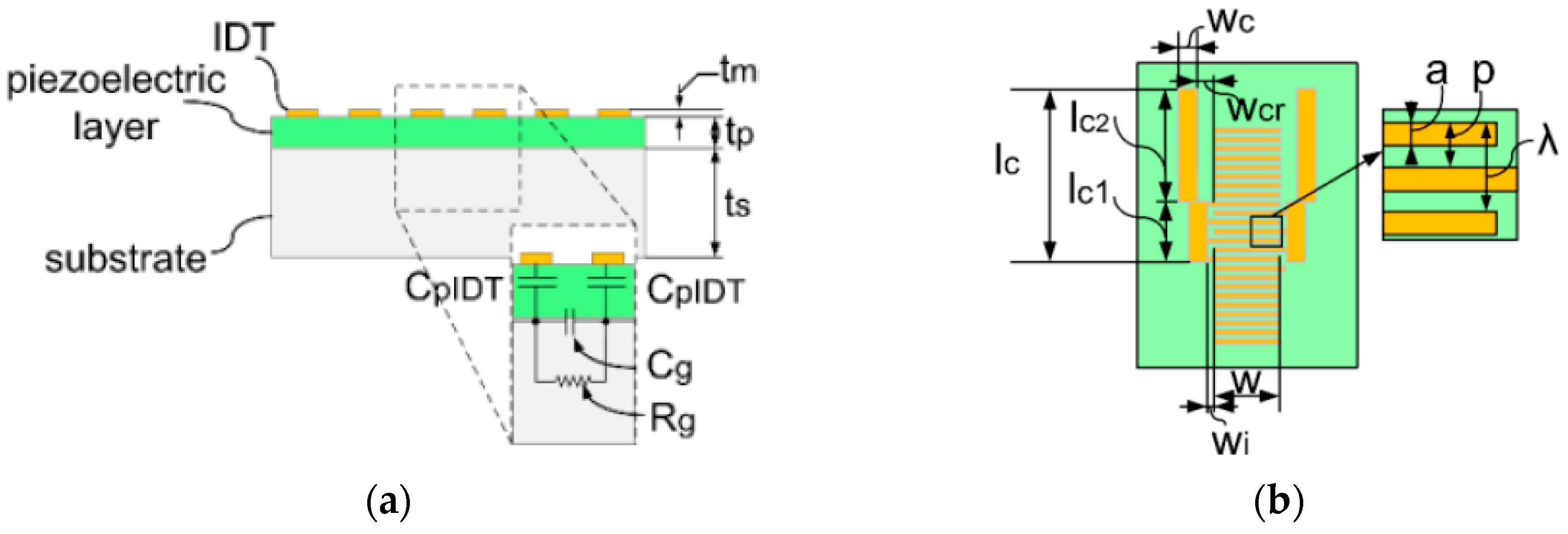
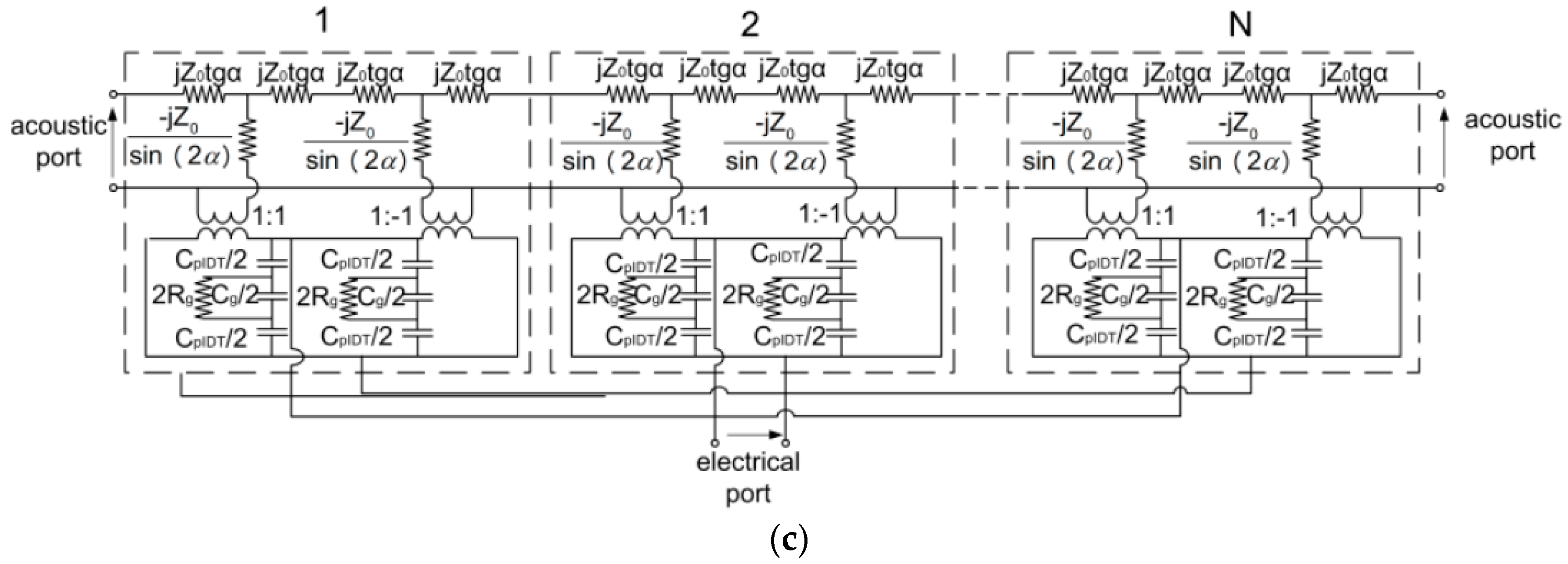

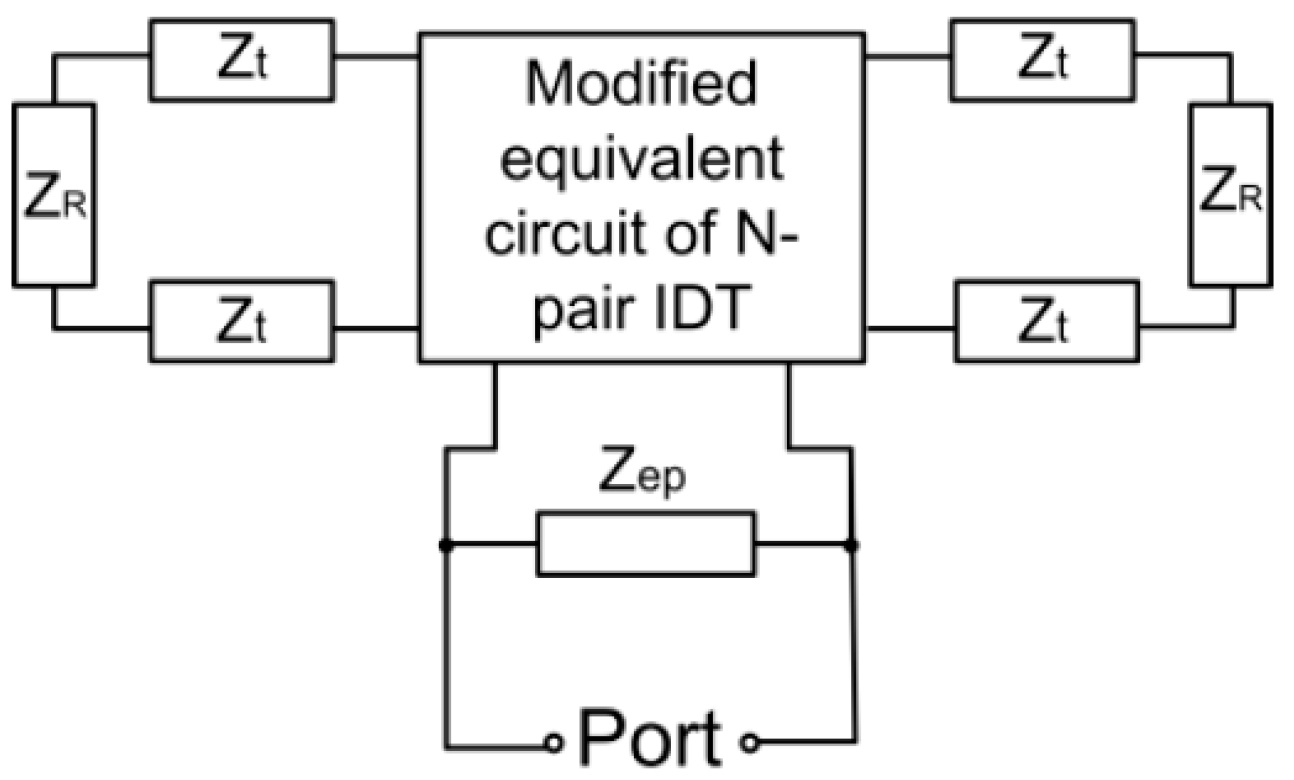

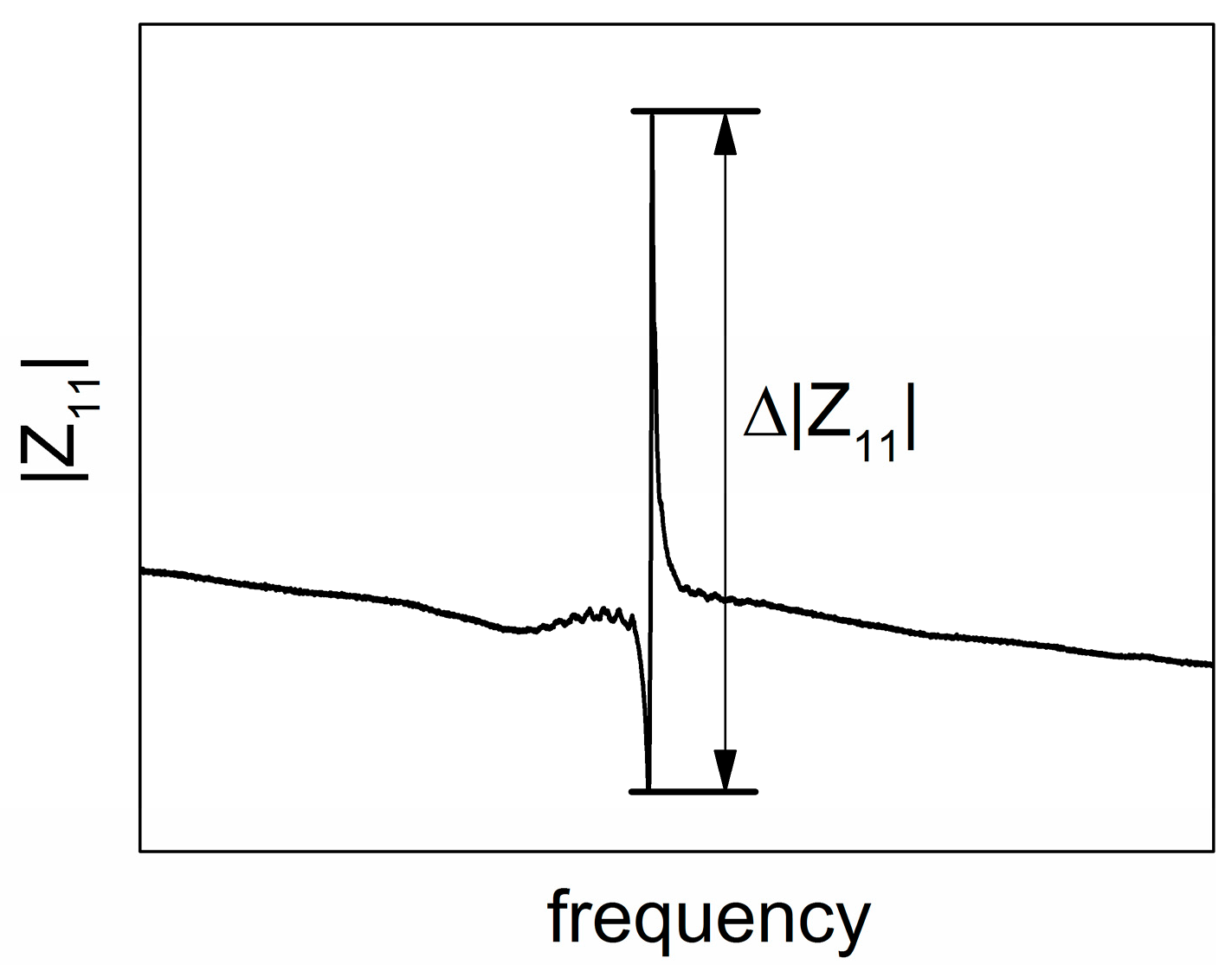
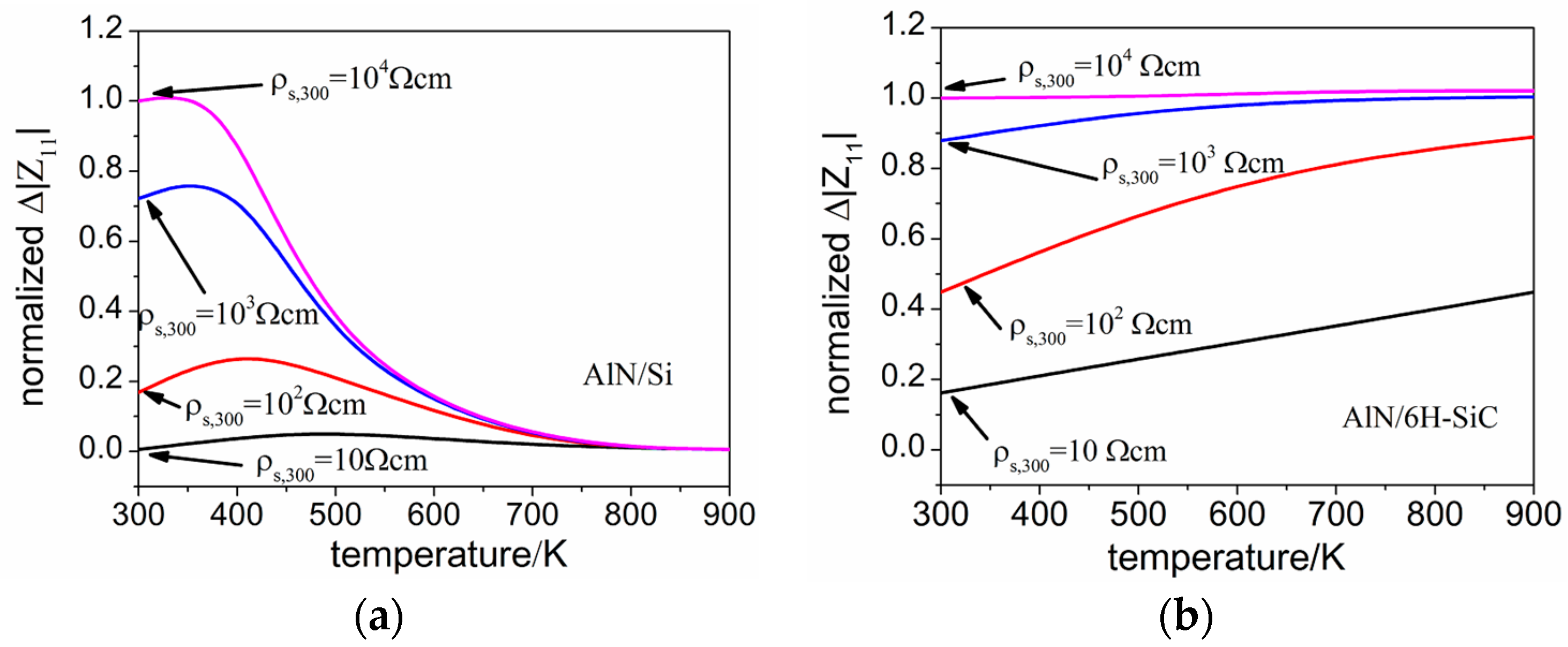
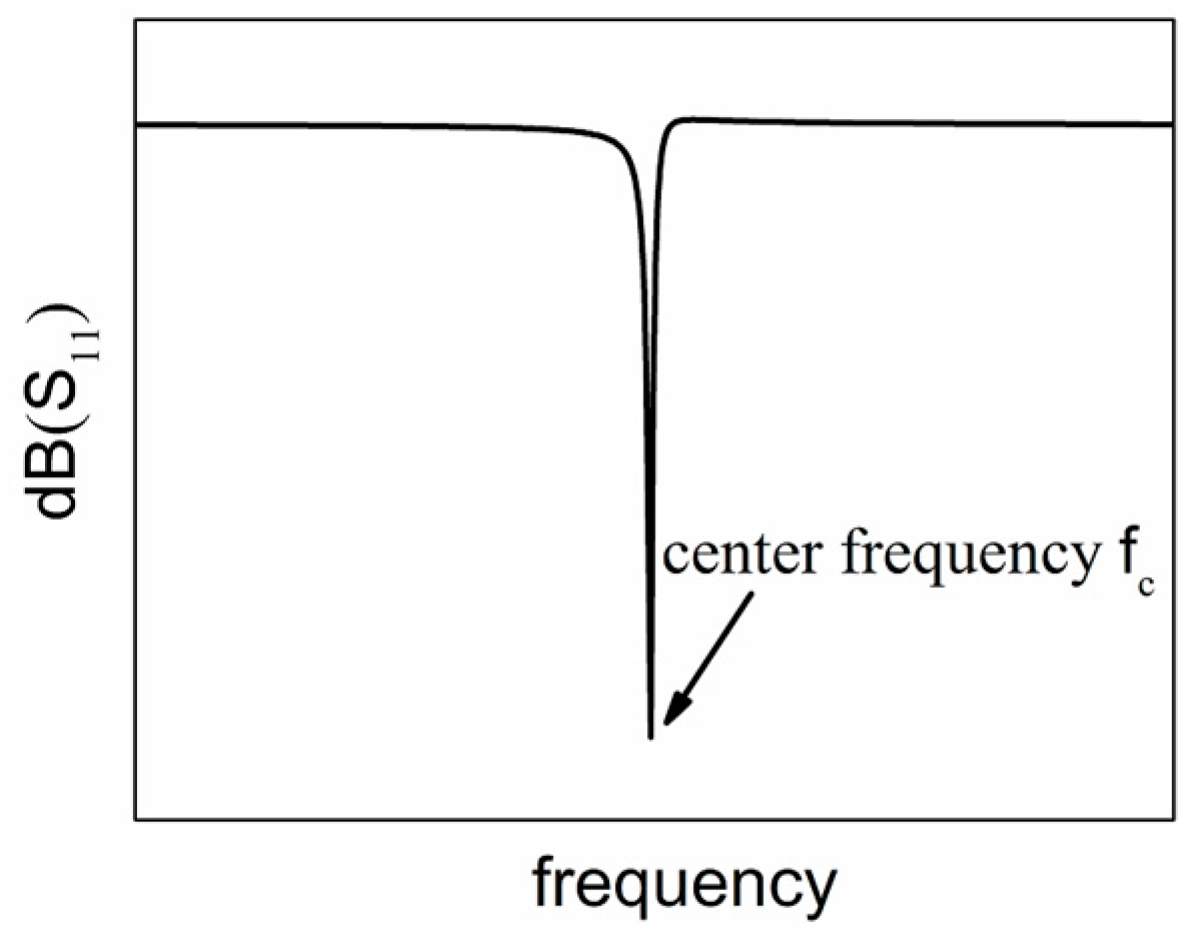
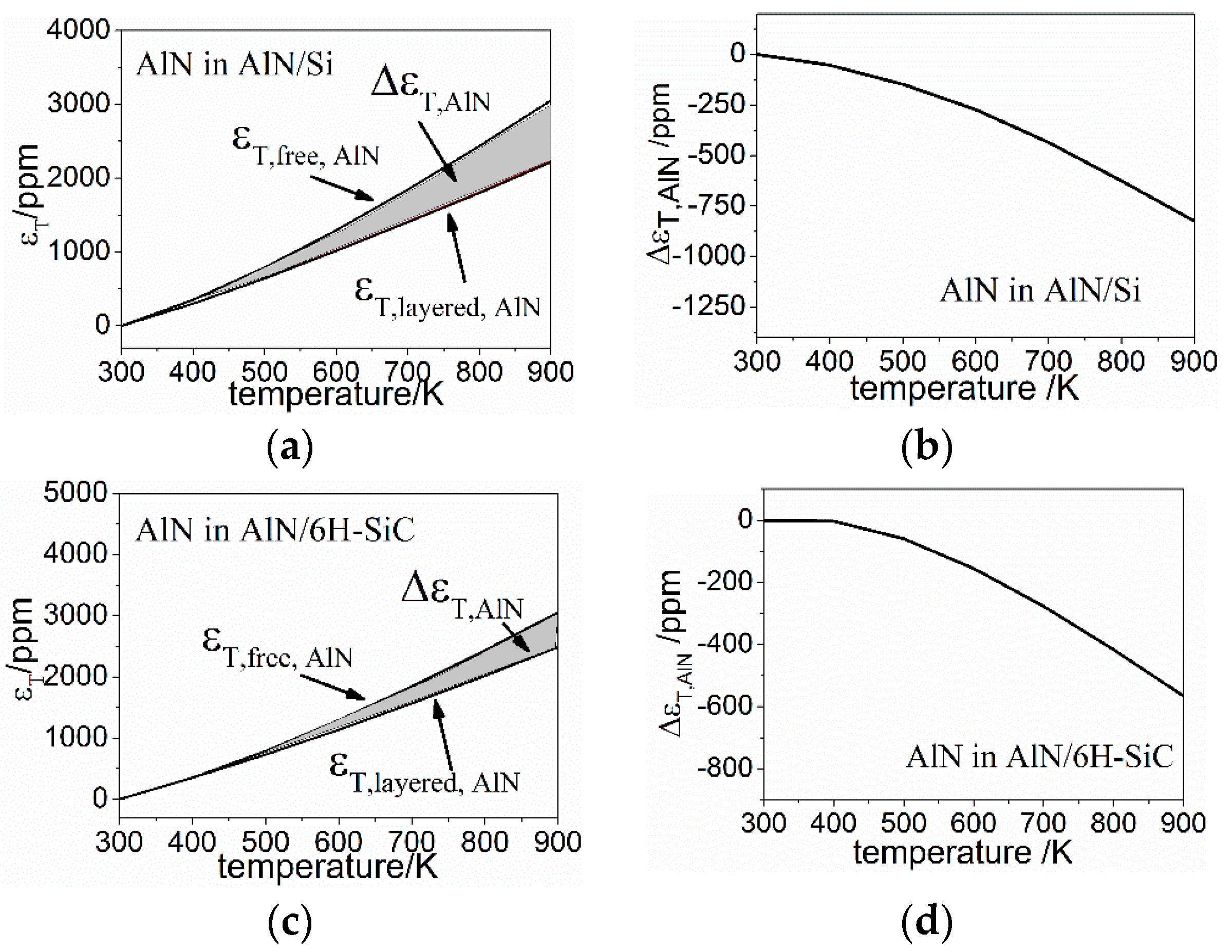
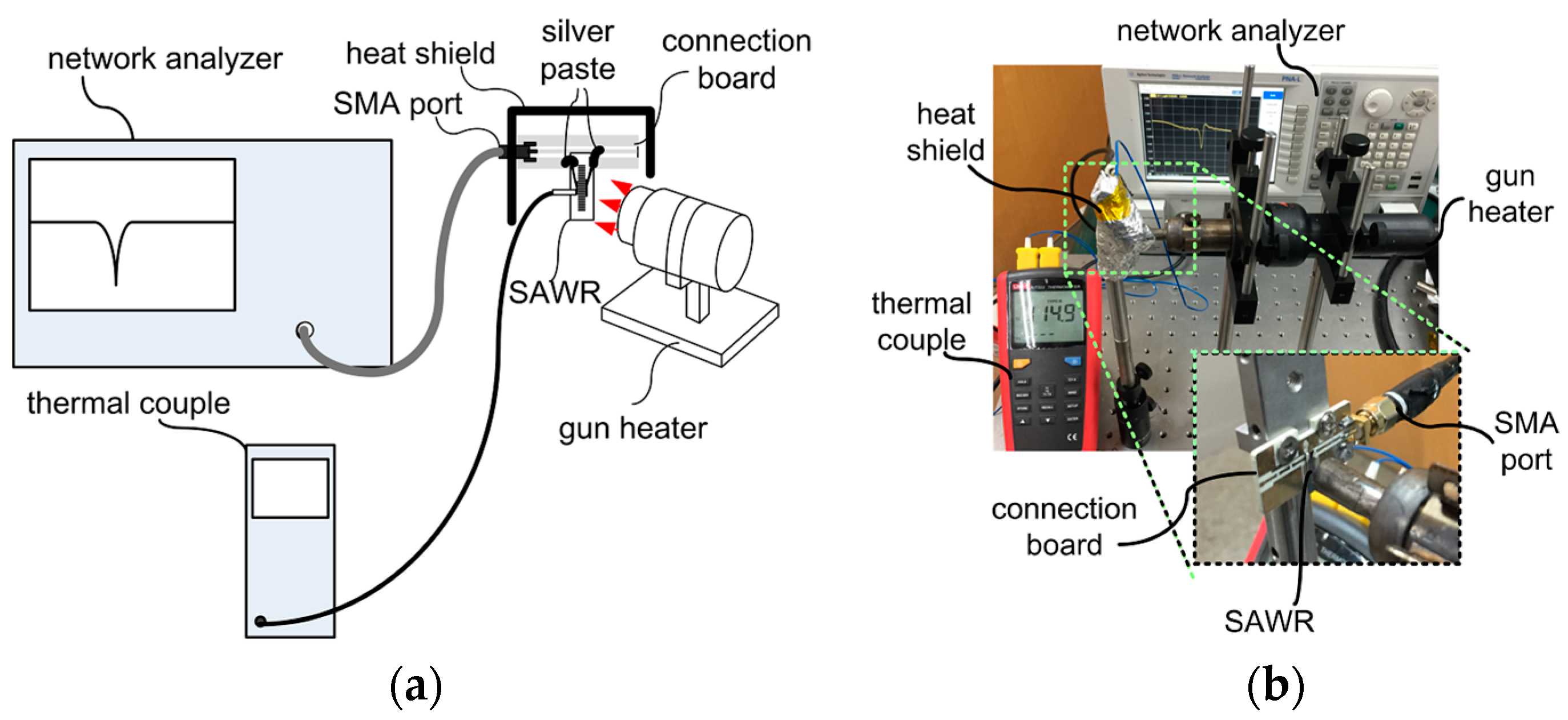
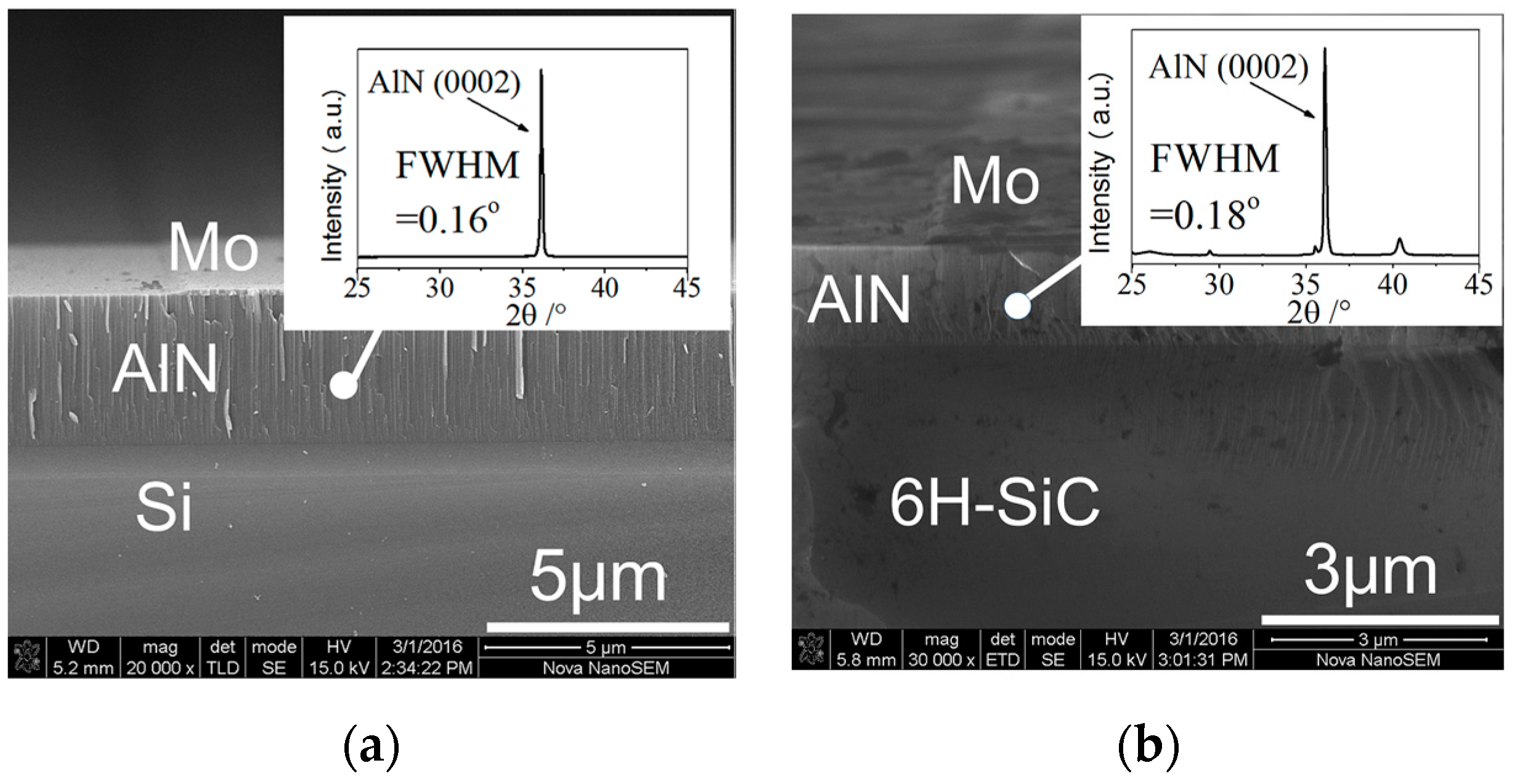
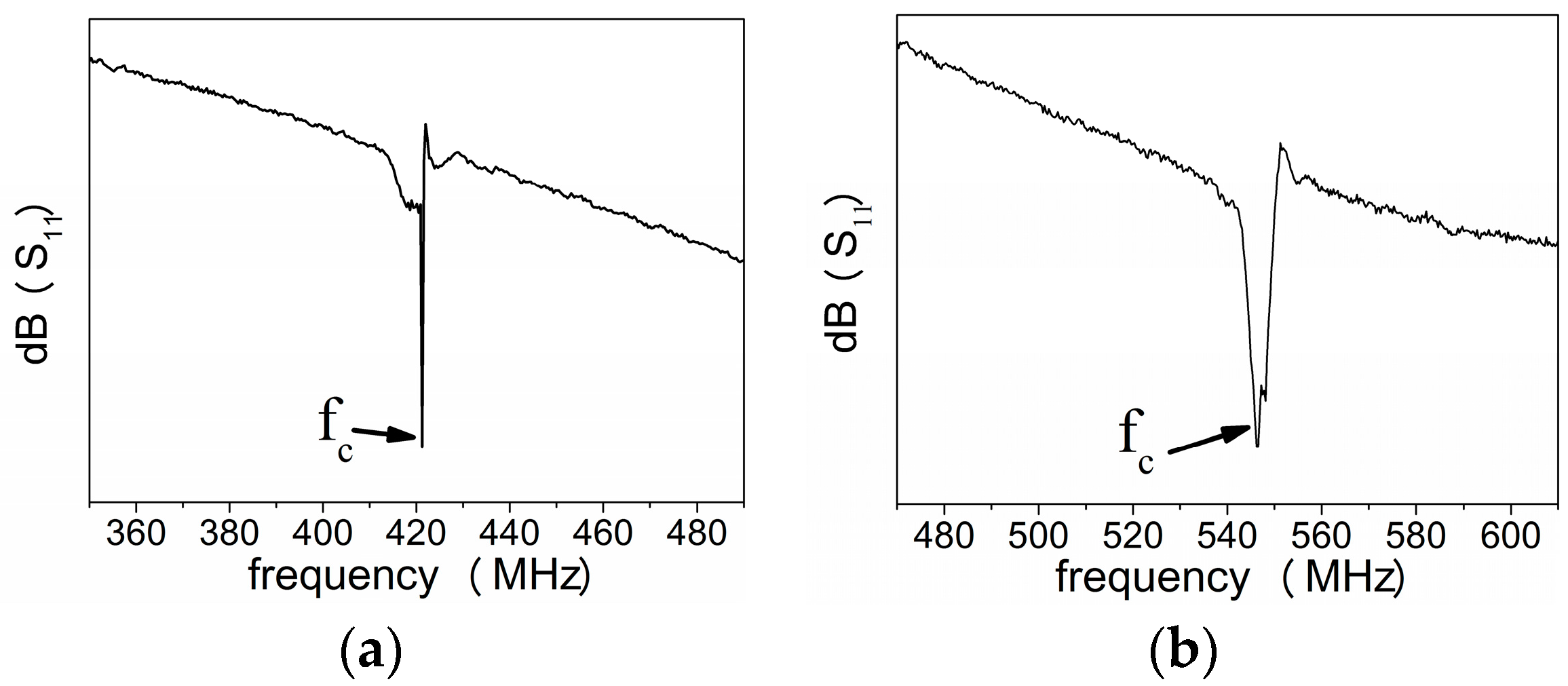
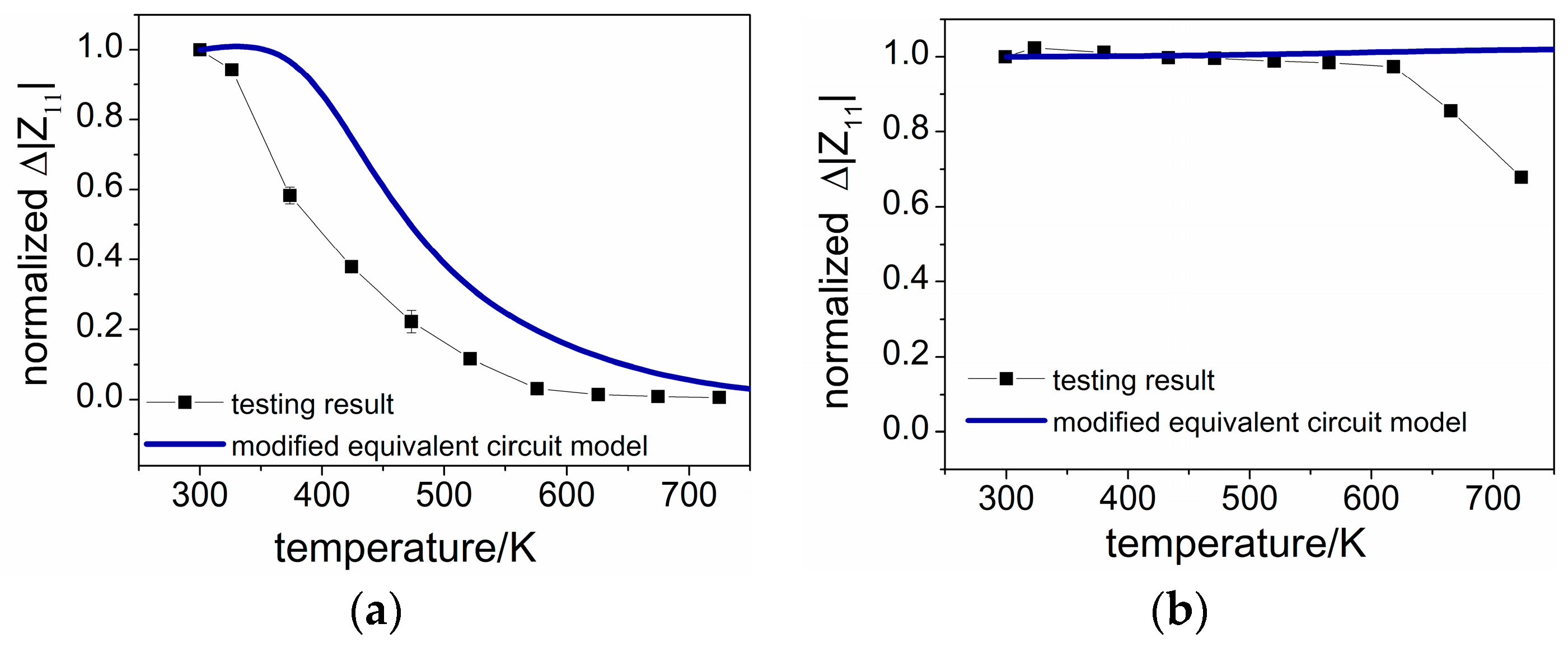
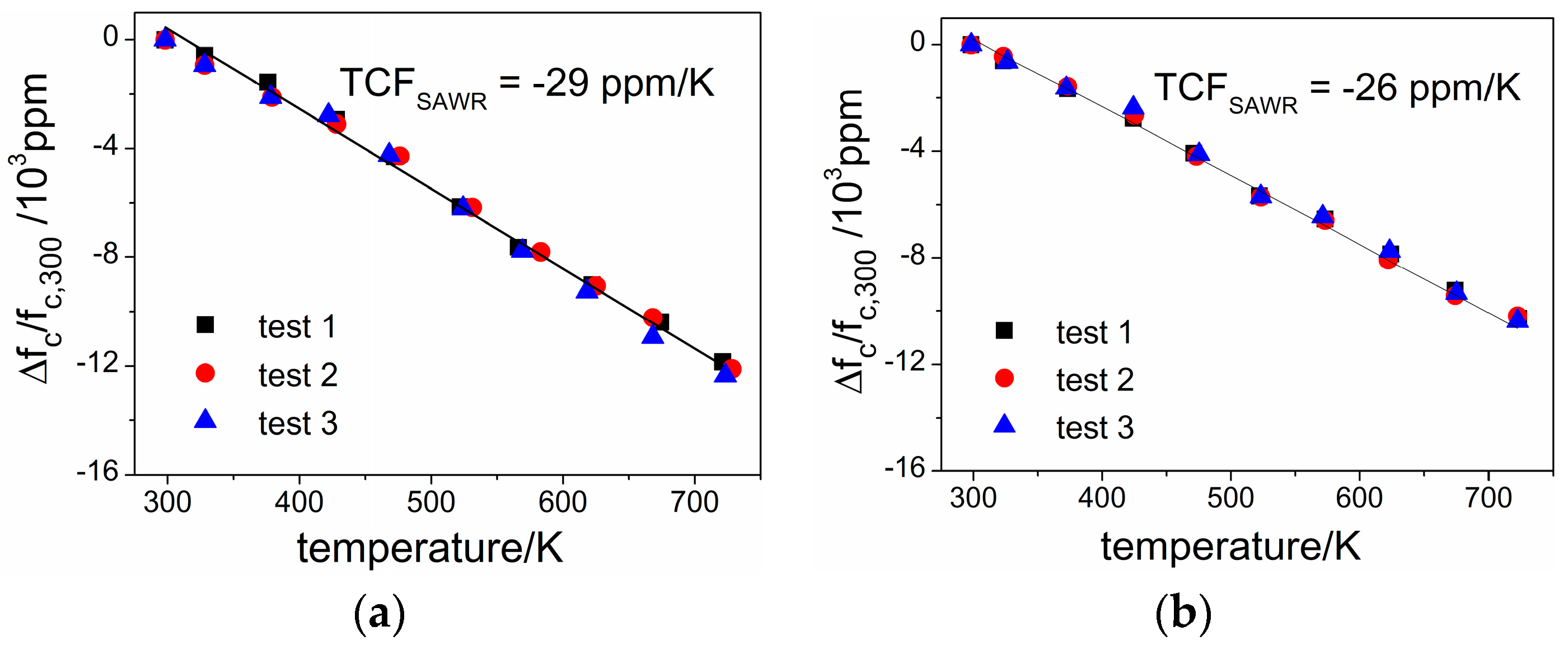
| Parameters | Value | Unit | Parameters | Value | Unit |
|---|---|---|---|---|---|
| cm/Vs | 5.41 × 1015 | cm−3K−3/2 | |||
| 400 | cm/Vs | 2.19 × 1015 | cm−3K−3/2 | ||
| 10, 102, 103, 104 | Ωcm | 17.3 × 1015 | cm−3K−3/2 | ||
| 10, 102, 103, 104 | Ωcm | 4.80 × 1015 | cm−3K−3/2 | ||
| 1.12 | eV | e | 1.6 × 10−19 | C | |
| 3.0 | eV | 1.3806 × 10−23 | J/K |
| / | /cm−3 | / | /cm−3 |
|---|---|---|---|
| 10 | 4.63 × 1014 | 10 | 1.56 × 1015 |
| 102 | 4.63 × 1013 | 102 | 1.56 × 1014 |
| 103 | 4.63 × 1012 | 103 | 1.56 × 1013 |
| 104 | 4.63 × 1011 | 104 | 1.56 × 1012 |
| Material | |
|---|---|
| AlN | −28 |
| Si | −26 |
| 6H-SiC | −25 |
© 2016 by the authors; licensee MDPI, Basel, Switzerland. This article is an open access article distributed under the terms and conditions of the Creative Commons Attribution (CC-BY) license (http://creativecommons.org/licenses/by/4.0/).
Share and Cite
Chen, S.; You, Z. Modeling and Experimental Analysis on the Temperature Response of AlN-Film Based SAWRs. Sensors 2016, 16, 1205. https://doi.org/10.3390/s16081205
Chen S, You Z. Modeling and Experimental Analysis on the Temperature Response of AlN-Film Based SAWRs. Sensors. 2016; 16(8):1205. https://doi.org/10.3390/s16081205
Chicago/Turabian StyleChen, Shuo, and Zheng You. 2016. "Modeling and Experimental Analysis on the Temperature Response of AlN-Film Based SAWRs" Sensors 16, no. 8: 1205. https://doi.org/10.3390/s16081205
APA StyleChen, S., & You, Z. (2016). Modeling and Experimental Analysis on the Temperature Response of AlN-Film Based SAWRs. Sensors, 16(8), 1205. https://doi.org/10.3390/s16081205






